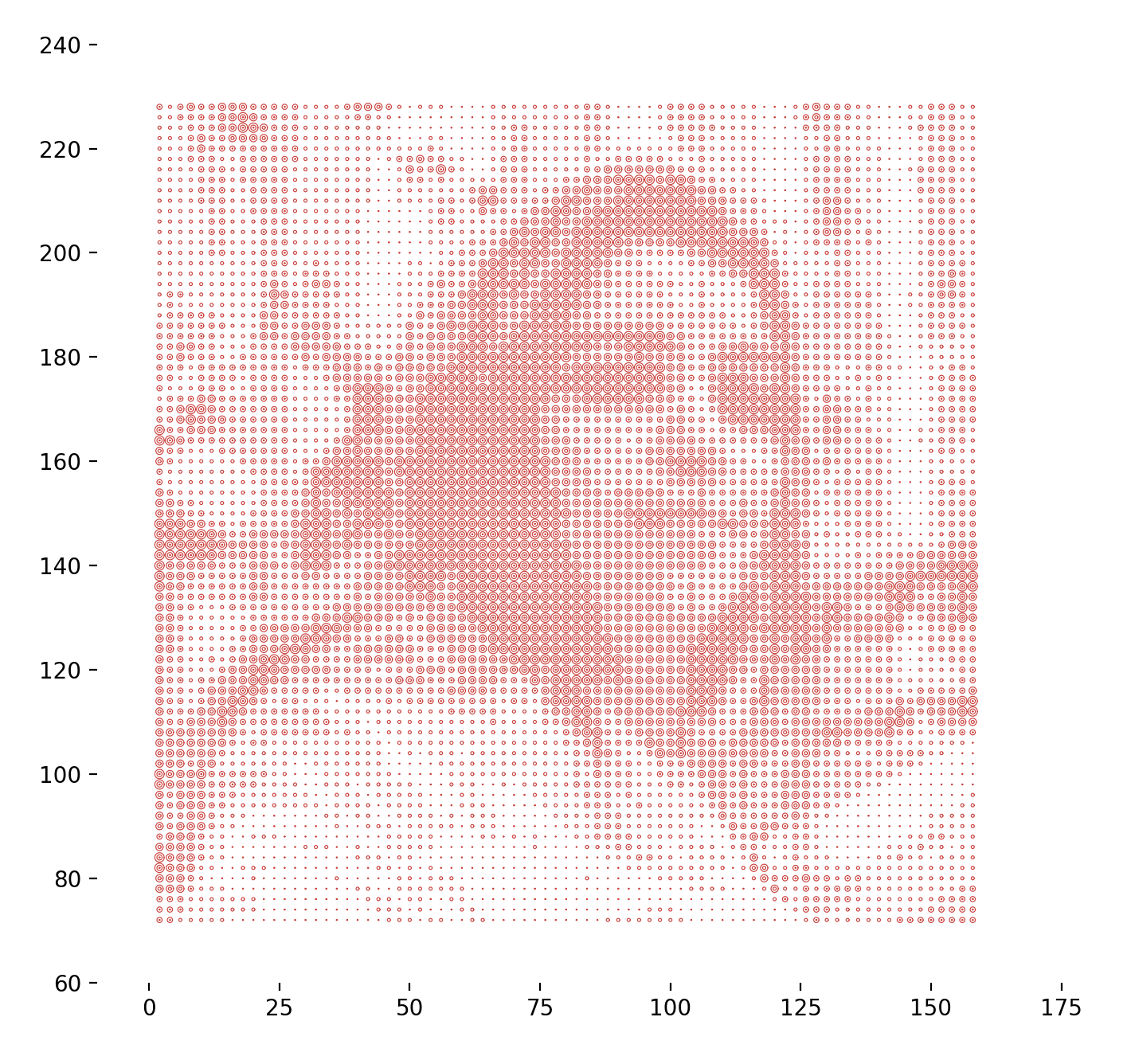2025-02-14 Circles
Description
Sample lightness/darkness sections of an image. Use those values to then plot circles of varying diameters.
Images



Plotter Preview

Code
warning
This code may or may not run and is intended more as a reference. Additionally, it was most likely not written with the latest version of the library. To ensure compatibility, check the date of this post against the version history and install the corresponding version.
from gcode2dplotterart import Plotter3D
from gcode2dplotterart import experimental_photo_utils
X_MIN = 0
X_MAX = 170
Y_MIN = 70
Y_MAX = 230
Z_PLOTTING_HEIGHT = 0
Z_NAVIGATION_HEIGHT = 1
layer = {
"title": "red_4",
"color": "#dd3031",
"line_width": 0.4,
}
MAX_WIDTH = X_MAX - X_MIN
MAX_HEIGHT = Y_MAX - Y_MIN
# Take in an image, such as size 1000x1000. Sample a 5px square for example,
# which results in 200x200 grid. Then we can draw 200x200 circles at diameter 1 each.#
SAMPLE_LENGTH = 10
OUTPUT_DIAMETER = 2
RADIUS_MAPPING = [
0.9 * OUTPUT_DIAMETER / 2,
0.7 * OUTPUT_DIAMETER / 2,
0.5 * OUTPUT_DIAMETER / 2,
0.3 * OUTPUT_DIAMETER / 2,
0.1 * OUTPUT_DIAMETER / 2
]
plotter = Plotter3D(
title="Circles",
x_min=X_MIN,
x_max=X_MAX,
y_min=Y_MIN,
y_max=Y_MAX,
z_plotting_height=Z_PLOTTING_HEIGHT,
z_navigation_height=Z_NAVIGATION_HEIGHT,
feed_rate=10_000,
output_directory="./output",
handle_out_of_bounds="Warning",
)
plotter.add_layer(
layer["title"], color=layer["color"], line_width=layer["line_width"]
)
image_path = "./1.jpg"
image = experimental_photo_utils.load_image(image_path)
# Calculate number of circles that will fit in each dimension
circles_width = MAX_WIDTH / OUTPUT_DIAMETER
circles_height = MAX_HEIGHT / OUTPUT_DIAMETER
# Resize image to match the number of samples we'll take
image = experimental_photo_utils.resize_image(
image,
int(circles_width * SAMPLE_LENGTH),
int(circles_height * SAMPLE_LENGTH)
)
# Convert image to float32 before processing to prevent overflow
image = image.astype('float32')
image = experimental_photo_utils.grayscale_image(image, method="average")
image = experimental_photo_utils.buck_image_even_histogram_distribution(
image, layer_count=len(RADIUS_MAPPING), preview=False
)
def are_all_pixels_in_bounds(row_index, col_index):
for i in range(int(row_index), int(row_index + SAMPLE_LENGTH)):
for j in range(int(col_index), int(col_index + SAMPLE_LENGTH)):
if i < 0 or i >= image.shape[0] or j < 0 or j >= image.shape[1]:
return False
return True
def average_area(row_index, col_index):
if not are_all_pixels_in_bounds(row_index, col_index):
return -1
total_area = 0
count = 0
for i in range(int(row_index), int(row_index + SAMPLE_LENGTH)):
for j in range(int(col_index), int(col_index + SAMPLE_LENGTH)):
total_area += image[i, j]
count += 1
return int(total_area / count)
for row_index in range(0, image.shape[0], SAMPLE_LENGTH):
# Don't print last row
if row_index > image.shape[0] - SAMPLE_LENGTH:
break
for col_index in range(0, image.shape[1], SAMPLE_LENGTH):
# Don't print last column
if col_index > image.shape[1] - SAMPLE_LENGTH:
break
radius = RADIUS_MAPPING[average_area(row_index, col_index)]
if radius == -1:
continue
# Start with the outer radius and draw concentric circles inward
current_radius = radius
while current_radius > 0:
plotter.layers['red_4'].add_circle(
x_center=X_MIN + (col_index / SAMPLE_LENGTH) * OUTPUT_DIAMETER,
y_center=Y_MIN + (row_index / SAMPLE_LENGTH) * OUTPUT_DIAMETER,
radius=current_radius)
current_radius -= layer['line_width']
plotter.preview()
plotter.save()